From: Beckington to Box
Distance: 15m / 24km
Cumulated distance: 320m / 515km
Percentage completed: 31.14
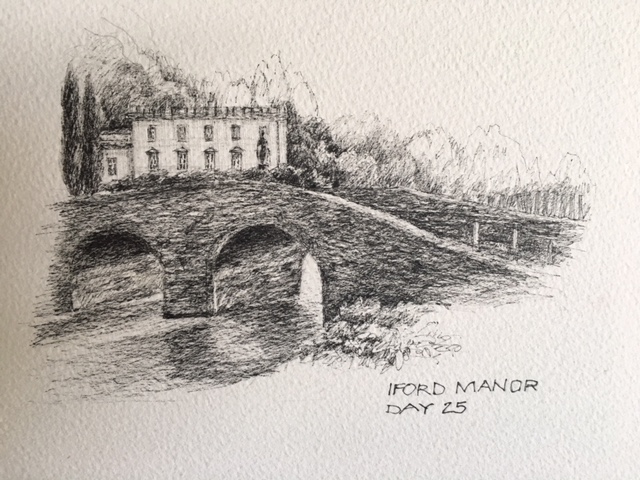
Today I got off to a cracking start. I realised that one of the reasons I was getting in so late was because I was leaving so late. Duh. Actually, breakfast is just served at a leisurely time in B&Bs. I totally get it .. if I was on a proper holiday there’s no way I’d want to be fed at 7am. The Woolpack was very accommodating and I was off by 7.30 this morning.

Woolpack at Beckington
After putting my feet up for the morning yesterday I went into Bath and got a terrific sports massage. It was a very restorative rest day which seemed to stretch on forever. I was grateful to feel its benefit had spilled over into today. I was hugely buoyed up by all the wonderful messages too .. thank you so much.
After leaving Beckington the first village I reached was Rode, or Road if you prefer the pre-1919 spelling of the town’s name. Once a big wool and cloth producing centre, it is now what they call a ‘dormitory’ town, with its good access to Bristol, Bath, Trowbridge and Frome. It hit the cover of Vogue in the 18th century, when a consortium of mills in the town won a national competition to manufacture a dress for Queen Charlotte, the wife of George III. The entrant to the competition used a new blue dye to colour the dress. Because of the association with royalty, the town was given a royal certificate which allowed them to market the colour as ‘Royal Blue’. Neat.
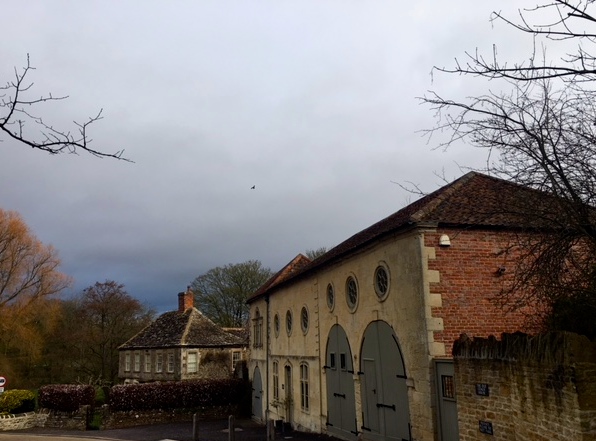
Rode village
Just another mile further on I walked through Tellisford, another former cloth village and one of the few ‘Thankful Villages’ in the country. The name was chosen to mark the fact that all of the young men from the village, who went away to serve in the First World War, returned home safely. It’s one of only 52 Thankful Villages in England and Wales. In France only one such village exists, not surprisingly. Somerset was particularly fortunate in that 9 of the 52 villages were in the county. ‘Doubly Thankful’ is a title referring to those villages who also remained unscathed by the Second World War. Quite extraordinarily, serendipity had the village in Normandy well within its sights, as it too became Doubly Thankful. What were the chances.
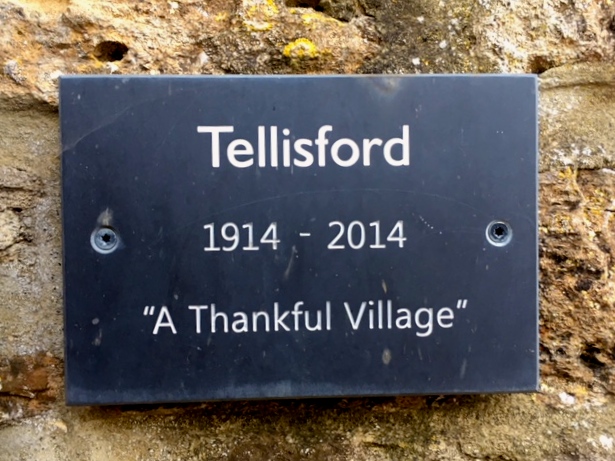
Plaque next to the village notice board
Close by the village of Tellisford there’s a pillbox. Like the pillboxes along the Thames, which seem very out of place, this one is part of a series, which was built to form the GHQ Line: General Head Quarters. Together with similar lines of pillboxes criss-crossing the country, the strategy was to compartmentalise the country and hold up the invading force while reinforcements were rushed to the front. I don’t know anything about military strategies, but this one sounds as if it would have been about as effective as the French Maginot Line. All very well to have these scathing views in hindsight, I suppose.
The Macmillan Way really delivered culturally today. A bit further on the route I came to IIford Manor, close to the River Frome. Although the manor is beautiful, it is the Grade 1 Italianate Garden which is the big attraction. It was designed by Harold Peto who lived at Iford for 30 years or so, making the design of the garden his life-long passion. Flowers play second fiddle to cyprus trees, statues, walks and water features. I could just see the spectacular water feature from the Way. I love the idea of returning to the garden in the summer when there is a 3 month long music festival, with jazz, opera and concerts taking place in the loggia and the cassita. Today the gardens were closed, although the gardeners were very much in evidence, delivering tons of mulch to prepare the grounds for Easter visitors.
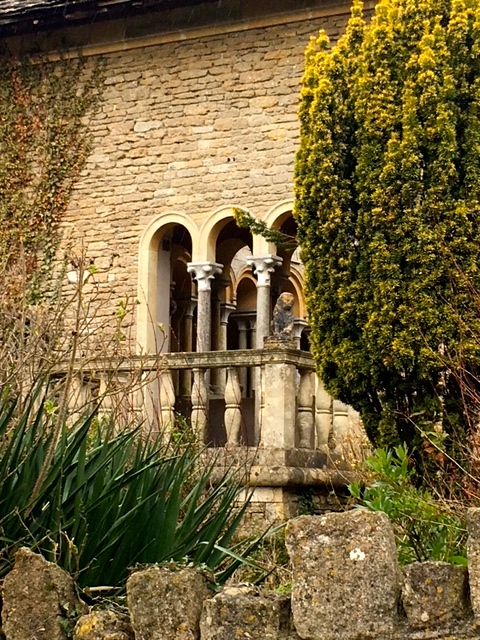
Iford Manor
I stopped to have my tea and biscuits in the porch at the parish church in Farleigh Hungerford. Having started the day early it felt so good to have the time to stop awhile and relax, soaking up the atmosphere of the English country churchyard, recalling Grey’s beautiful poem.
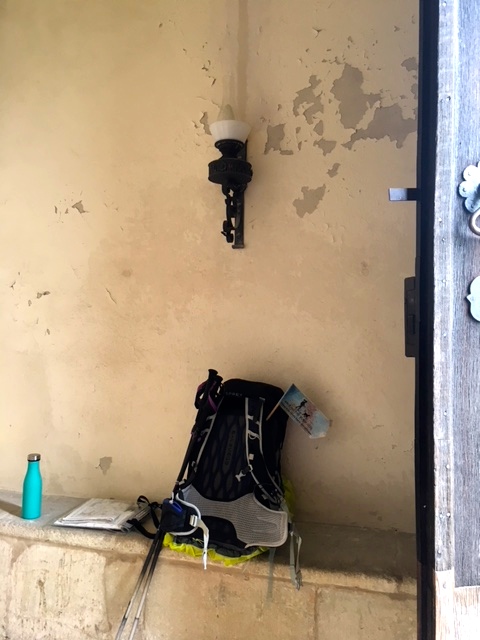
Pit stop
Farleigh Hungerford is home to Bath Rugby Club’s training ground: Farleigh House. It’s a hopelessly romantic building of Gothic Revival style .. although the chapel is now a gym and the outbuildings have been redesigned to look after all the medical needs of the squad. It’s not a bad place to train.
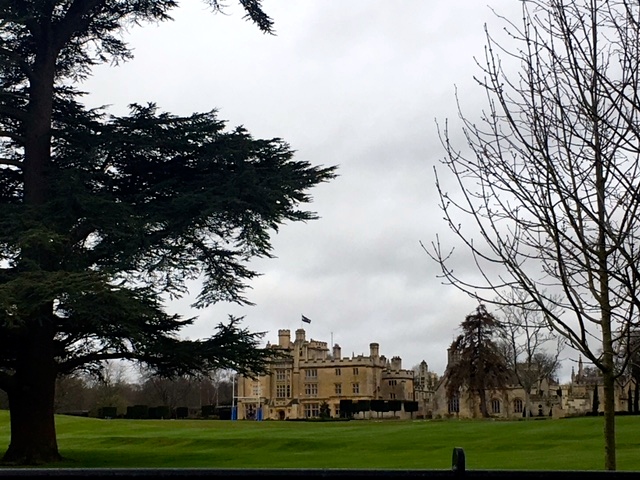
Farleigh House
Out the other side of the village are the ruins of Farleigh Hungerford Castle. The castle has a long and dramatic history linked to the fortunes of the Crown and Parliament. Sir Thomas Hungerford was elected as the First Speaker of the House of Commons and his son was knighted by Henry VI, later fighting at Agincourt after which he received the Knighthood of the Garter. However in the War of the Roses, the family lost their lives and their castle to the Crown. English Heritage looks after the site and looks to do much to bring history to life there .. there are battle reenactments, lively story-tellings and a great audio guide educating the listener about some of the characters of the castle from over the years. They tell the story of the spendthrift Sir Edward Hungerford IV, who gambled away a manor on a single throw at a bowling match and the tale of the murder and burning of John Cotell in the castle kitchen. As with the National Trust, English Heritage opens all its sites around the country at Easter each year .. it’ll be great to see some of them along the way.
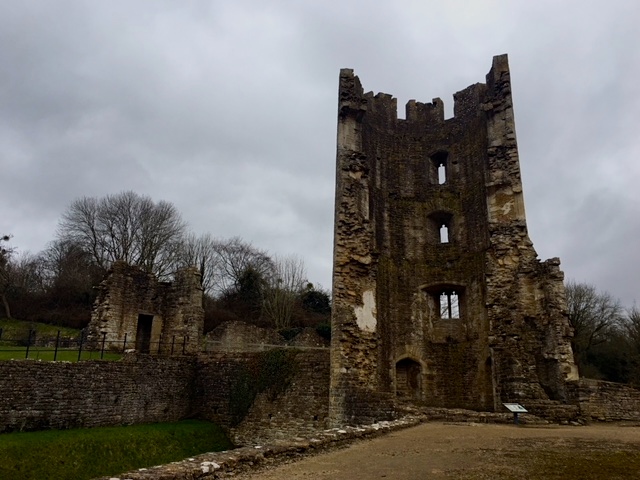
Ruins of Farleigh Hungerford Castle
And then it was on to Bradford-upon-Avon. A couple of locals advised me to take the canal route into town. I was so glad they did as the route was quietly beautiful in the rain.
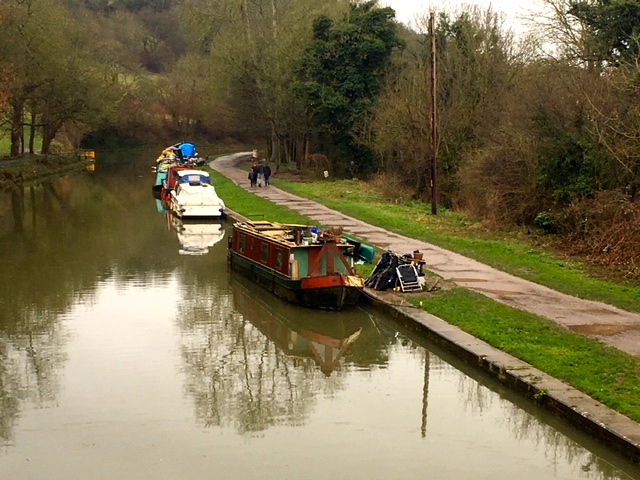
Barges on the canal
Did I mention it was raining?

Weather for ducks
Bradford on Avon was made wealthy by the river .. which powered the mills .. which made the cloth .. which created the garments .. which were bought by all and sundry. The cottage industry soon became factory based and was augmented by the arrival in the 17th century, of two particularly fine Flemish weavers. Their names are commemorated on a plaque in Church Street. However, as the cloth industry lost out to keener competition of the mills of northern England, the other Bradford among them, the factories gradually lay derelict. However, all was not lost. As rubber came in from the colonies, warehouses were needed to process it and this gave Bradford-upon-Avon a whole new lease of life.
Bradford on Avon lies on the River .. yep, Avon. It’s built in a valley with steep, steep sides which makes for a very attractive view of the town, from either the river or from the top of the hill.

From the bottom ..
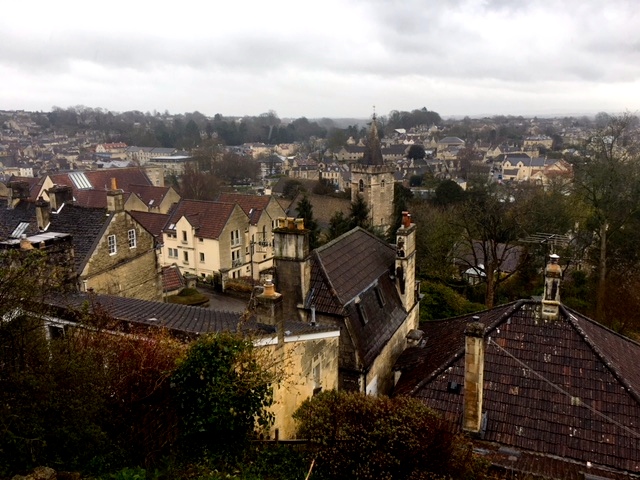
.. and from the top
All these references to industry, mills and rubber might lead you to think that BoA is not that attractive. But no .. it really is astonishingly pretty. It has the same beautiful bleached stone that it’s more famous neighbour, Bath has and while it’s less grand it’s really very charming.
Now, did I tell you it was raining? This is what it looked like for a lot of the day:

Wet and grey
In fact, once I’d taken this photo I parcelled my iPhone up in its clever little plastic pouch, convinced that I wouldn’t be taking any more photos. Ten minutes later I was grappling in my jacket to find it before the mother of all rainbows evaporated.

Fantastic afternoon light
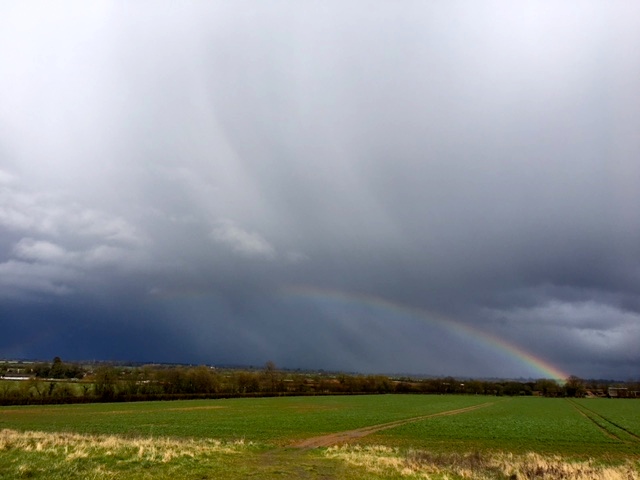
Dramatic sign of hope

Collision of two very different skies
The drama which came and went so quickly, more than made up for the mud-trudging of the afternoon. I was awed by it.
I didn’t get to Lorne House in Box until 6 o’clock but it had really been a richly cultural day with the time to stop and ponder a while in church porches, on canal bridges, atop stiles and from the tops of soft hills. It had really brought back into sharp focus the enjoyment and the reason I was doing the walk. Great feeling! Oh, and there’d been humour too!

Tee hee!
Black Dog Tails
Jet helped to rescue a phenomenal 150 people from a bombed building during the Second World War. His proud owner was Mrs Babcock Cleaver. In July 2016 pupils of Childwall Primary School cleaned the nearby memorial, where Jet is buried and had a birthday celebration for him. Also in attendance was 93 year old Lilias Ward (née Cleaver) Jet’s former owner.
![]()


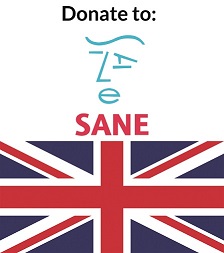
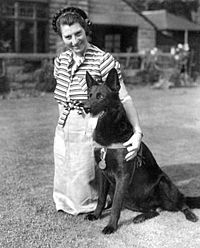
What a bright and positive blog to wake up to on Easter Friday my friend ! Thank you and Well done for digging deep and finding the strength to continue your walk . Your red dot on the map is moving up nice and steady , you are awesome . Loving your photos with moody skies and cloud formations , feeling so inspired . That dog sign is a classic and should be used around the world . All my love and support xox
Sophie, my friend .. thank you for your continuing support. You are a complete star and a mainstay in my life. xx
Bravo Jules! You have regained the wonder and the joy. Yes, an early start is very important and those tea and lunch stops as well. Space to contemplate. Loved the blog and photos which show you are not only walking through history but also in the world of story. Lovely. xx
There was something you mentioned about walking through the pain threshold, that really resonated, Marilyn. I realised that the bruised soles of the feet had come about because I normally walk on tarmac or at least, level ground in Sydney. Bruising passes and indeed today the walking felt much easier, with the shoes returning to their usual comfort. Even in torrential rain! xx
Glad today was a good day!
And today even better .. met a Bosco in a tearoom who I must send you a photo of .. he was adorable. x
Thierville, the Thankful Village in Normandy, were indeed lucky not to lose any soldiers in WW1 as 1.4m French soldiers died during the war. But less surprising that they because Doubly Thankful since far fewer French soldiers were killed in WW2 (around 200,000)
Monsieur le Professeur, I also suspect that Thierville would have been a very tiny village, just like Tellisford.
Very happy to read that today went so well – a rest day in Bath and a good massage sound like the ideal way to recharge your batteries. Loving the cloud and rainbow photos too!
Yep, got my mojo back! Even with the rain I had another great day today. Think you and Mr Light will enjoy the Black Dog Tail today .. although I’m slightly concerned about Tots and Pinkie feeling left out. Will have to do something about that. xx
Jules, I am enjoying your blog so much, and the spectacular photos and even more spectacular drawings. And the Lab stories …..well Chuckles would be so proud and jealous that he’s not walking with you, although from above I am sure he is.
Sarah! How lovely to hear from you. I imagine your two would love to be romping through the mud and enjoying the English countryside. I LOVE the idea of Chuckles sharing the walk with me from doggy heaven. He was such a sweet dog. xx
So glad you had such a restorative rest day! Bath is amazing at any time and obviously worked it’s magic. Loved the Woolpack Inn pub sign too – a work of art! Passing your daily musings on to anyone I meet – so they too can benefit from snippets of English (and later on Scottish!) history and hitherto unseen views of beautiful countryside. Lots of love xx
Hey Frannie .. wouldn’t that be a wonderful outlet for your fabulous art: pub signs!! They could be an English extension of your Sydney power box designs. Thanks for spreading the word. Much appreciated. Big hugs xx
Hello Jules, What a privilege to read your blog and to venture virtually with you to the tip of Scotland. Your website alone is amazing with its beautiful drawings, photographs and writing. I miss you and the UK; thank you for coming back to richly to my life. I’m with you in spirit all the way. With much love and admiration, Juliet
Hello Juliet, coming from you that’s such a compliment! I’ve always admired your way with words. It is wonderful to have you by my side as I walk, even if it is metaphorically. I draw a great deal of support from thinking of the friends who are in the ether around me. Much love, Jx
Hi Jules,
Love the daily blogs, you manage to incorporate local history and nature and weave it into the fabric of the area you are in.
I am a friend of Jeremy Forth, known him for over 30 years when we met at Manchester polytechnic doing orthodontics , and he told me about your adventure.
I am planning to join you for a day when you arrive in North Yorkshire as I live up there.
Do you know the dates you will be coming in to and leaving Hawes ?
Cheers Jules , watch out for the peat bogs in the Peak District. Derek.
Nice of you to make contact, Derek. I’m not totally sure at the moment but probably late May. I’ll let you know via email. Thanks for the peat bog warning! Jules
Hi Jules. You’ll be passing through my home town – Sherston – today or tomorrow I think. I’ll be in London from lunchtime, back Saturday night, otherwise we could have met up before my joining you with Nigel on Tuesday. I can recommend the Rattlebone Inn pub (my beloved local) and the Angel cafe/coffee shop/restaurant for sustenance. Where are you staying?
I admire you plodding through this shitty wet weather, but like yesterday I’m sure you will have some beautiful bright moments over the weekend.
John.
Hi John .. I’m staying at the Angel! In fact, just ordered a large glass of wine, next to the fire. I’d intended to get to the Rattlebone but the soaking I got today means I’m a tad reluctant to go out again .. even though it’s not far. How lucky are you to live in Sherston!
That late time for breakfast thing is a nuisance. I always negotiate hard (but politely), and if that fails to get an early start I ask for a DIY breakfast to be prepared and left out for me the night before – toaster, marmalade cereal and tea or whatever and that often works. The feeling of elation when you take the first steps of an early start annul the disappointment of missing a cooked breakfast.
Great idea to request a serve yourself brekkie. I’ve really enjoyed getting away early the last two days. Even meant I got an hour’s walking today before the rain set in.
Your duck photo is a masterpiece
… looking forward to the book that will follow the walk which has all your lovely commentary and photos
Thank you so much! I’m hoping you’ll enjoy the Black Dog Tail today Mr Wild!
You write so beautifully Jules. I am learning more history of this area than I ever knew. You should write a book. Glad you enjoyed Bath and that you had a good deep tissue massage. I keep thinking of you today . It is both cold and wet. Hope you are not in too much discomfort. Very glad you had such an uplifting and cultural walk yesterday. The photos are terrific and your charming sketch of Ilford Castle. Multi-talented lady.
Happy Easter. Let’s hope it will be a dryer day. Lots of love , Anthea and Jasper xx 🦋🎇
Thank you, Anthea! It has indeed been a very, very wet day today but there were many places I walked through to lift the spirits. All the comments that are submitted have to be moderated personally by me! I try to get to them daily but it really does depend on how much time I have after walking, washing, eating, phoning family and writing the blog. Sorry you’ve been disappointed. Pats to Jasper and love to you!
Because I put a couple of little symbols, my comment is awaiting moderation. Same thing happened three days ago and the comment still has not been moderated. In case my earlier comment of today fails to show . Here it is again, more or less. You write so well and so informatively that I am learning a great deal of local history and thoroughly enjoying it. You should write a book and illustrate it with your charming drawings. Very glad you had a relaxing day in Bath and that yesterday was such a cultural delight on your 15 mile trek. The rainbow must, indeed, have been encouraging. Thinking of you most particularly on this cold, wet day. Happy Easter and may the weather be a great deal better.
I notice that all the times are Australian, which means each post is 11 hours ahead of British Summer Time. I belueve Australia goes an hour back very soon. With our love, Anthea and Jasper xx
Sorry to be a pain. My two comments submitted several hours ago are still “awaiting moderation”. Can you see them? Could you let me know why the status is like this and not showing up as they did before? Four comments are now “awaiting moderation”. Two today, one yesterday (29th) and one on Day 23, I think. I registered four days ago and do not understand what I am doing wrong.
Thank you for explaining about moderating the comments. Sorry that two more appeared from me after your explanation. xx